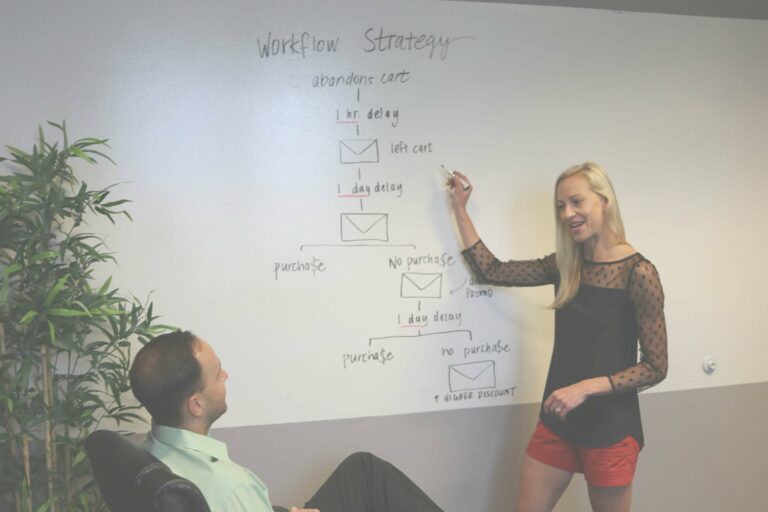Effective Website Layout Design: The Ultimate Guide
The Art of Effective Website Layout Design
In today’s digital landscape, having an effective website layout design is crucial for businesses looking to make a lasting impression online. A well-designed layout not only enhances the visual appeal of your website but also improves user experience, increases engagement, and drives conversions. Let’s explore the key principles and strategies behind creating an effective website layout design that resonates with your target audience.
Understanding User Behavior
Before diving into layout design, it’s essential to understand how users interact with websites. Research has shown that visitors tend to scan web pages in specific patterns, such as the Z-pattern and F-pattern. By aligning your layout with these natural scanning behaviors, you can guide users’ attention to the most important elements on your page.
Key Principles of Effective Website Layout Design
- Visual Hierarchy: Establish a clear hierarchy of information using size, color, and positioning to guide users through your content.
- White Space: Utilize negative space effectively to create a clean, uncluttered design that improves readability and focus.
- Consistency: Maintain a consistent layout across your website to create a cohesive user experience and reinforce your brand identity.
- Responsive Design: Ensure your layout adapts seamlessly to different screen sizes and devices for optimal viewing experiences.
- Navigation: Implement intuitive navigation that allows users to easily find the information they’re looking for.
Popular Website Layout Patterns
Several layout patterns have proven to be effective for various types of websites. Some popular options include:
- Single Column Layout: Ideal for mobile-first designs and content-focused websites.
- Grid Layout: Perfect for showcasing multiple products or portfolio items.
- Split Screen Layout: Effective for presenting two distinct options or contrasting ideas.
- Card-Based Layout: Great for organizing and displaying diverse content types.
When choosing a layout, consider your website’s goals and content type. For example, e-commerce websites often benefit from grid layouts, while long-form content may work better with a single column design.
Optimizing Your Layout for SEO
An effective website layout design should also consider search engine optimization (SEO). Incorporate these SEO-friendly practices into your layout:
- Use proper heading tags (H1, H2, H3) to structure your content
- Optimize page load speed by minimizing large images and unnecessary elements
- Ensure your layout is mobile-friendly, as mobile-first indexing is now a crucial ranking factor
- Optimize your website’s URL structure for better crawlability and user understanding
By implementing these principles and strategies, you can create an effective website layout design that not only looks great but also performs well in search engine rankings and user engagement. Remember, the key is to continually test and refine your layout based on user feedback and behavior analytics to ensure it meets the evolving needs of your audience.
Understanding the Basics of Effective Website Layout Design
Mastering the Fundamentals of Effective Website Layout Design
Before diving into specific strategies, it’s essential to grasp the fundamental concepts that underpin effective website layout design. These principles form the foundation of any successful web design project and are crucial for creating a user-friendly, visually appealing website that achieves its goals:
- Visual Hierarchy: Arranging elements to guide users’ attention and create a clear path for information consumption. This involves using size, color, contrast, and positioning to emphasize important elements and create a natural flow for the user’s eye.
- Balance: Distributing visual weight across the layout to create a sense of stability and harmony. This can be achieved through symmetrical or asymmetrical design, depending on the desired effect and content structure.
- Consistency: Maintaining a cohesive design throughout the site to enhance user experience and brand recognition. This includes consistent use of colors, fonts, button styles, and overall design elements.
- White Space: Using negative space strategically to improve readability, focus attention on key elements, and create a clean, uncluttered look. Effective use of white space can significantly enhance the overall design and user experience.
- Responsive Design: Ensuring the layout adapts seamlessly to different screen sizes and devices, providing an optimal viewing experience across desktops, tablets, and smartphones.
Implementing these core principles is crucial for creating a website that not only looks great but also functions effectively. At Web Design London, we incorporate these principles into every project, ensuring that our clients’ websites are not only visually stunning but also highly functional and user-friendly.
Moreover, understanding and applying these principles can significantly impact your website’s performance in search engines. A well-designed website that prioritizes user experience is more likely to engage visitors, reduce bounce rates, and improve overall SEO performance. Our approach to effective local SEO strategies complements these design principles, helping businesses increase their online visibility and attract more customers.
By mastering these fundamentals and staying updated with current web design trends, you can create a website that not only meets but exceeds user expectations, driving engagement and conversions for your business.
10 Strategies for Effective Website Layout Design
10 Powerful Strategies for Effective Website Layout Design
Creating an effective website layout design is crucial for engaging visitors and achieving your online goals. Here are ten powerful strategies to optimize your website’s layout:
- Implement a clear visual hierarchy: Guide users’ attention to the most important elements first, using size, color, and positioning to create a natural flow of information.
- Use whitespace effectively: Incorporate ample whitespace to improve readability and create a clean, uncluttered look.
- Optimize for mobile responsiveness: Ensure your layout adapts seamlessly to different screen sizes and devices.
- Incorporate website analytics: Use data-driven insights to refine your layout based on user behavior and preferences.
- Focus on user experience (UX): Design with your users in mind, prioritizing intuitive navigation and easy access to key information.
- Ensure fast loading times: Optimize images and code to minimize load times and improve overall performance.
- Use high-quality, relevant images: Incorporate visuals that enhance your content and align with your brand identity.
- Implement intuitive navigation: Create a logical menu structure that allows users to find information quickly and easily.
- Optimize for search engines (SEO): Implement on-page SEO best practices to improve your website’s visibility in search results.
- Include clear calls-to-action (CTAs): Guide users towards desired actions with strategically placed, compelling CTAs.
By implementing these strategies, you’ll create a website that not only looks great but also performs well and engages your visitors effectively. Remember, an effective layout is essential for businesses looking to establish a strong online presence and achieve their digital marketing goals.
The Impact of Effective Website Layout Design on User Experience
Effective Website Layout Design
An effective website layout design is crucial for creating a successful online presence. It goes beyond mere aesthetics, significantly impacting user interaction, brand perception, and overall site performance. Let’s explore the key elements that make a layout design truly effective:
Key Benefits of an Effective Layout
- Enhanced User Experience: A well-structured layout guides visitors through your content seamlessly, improving overall usability and satisfaction.
- Improved Navigation: Intuitive navigation helps users find information quickly, reducing frustration and increasing engagement.
- Increased Conversions: Strategic placement of calls-to-action (CTAs) and important elements can significantly boost conversion rates.
- Better Brand Perception: A professional and cohesive layout design builds trust and credibility with your audience.
- Optimized for SEO: Well-structured layouts can improve search engine rankings by making it easier for crawlers to understand and index your content.
Essential Elements of Effective Layout Design
To create a layout that truly works, consider incorporating these key elements:
- Visual Hierarchy: Use size, color, and positioning to guide users’ attention to the most important elements first.
- Whitespace: Proper use of whitespace (or negative space) can improve readability and focus.
- Responsive Design: Ensure your layout adapts seamlessly to different screen sizes and devices.
- Consistent Branding: Maintain consistent colors, fonts, and styling throughout the site to reinforce brand identity.
- Clear CTAs: Make your calls-to-action stand out and easy to find.
Layout Design Best Practices
Follow these best practices to create an effective website layout:
- Keep it Simple: Avoid cluttered designs that can overwhelm users. Stick to clean, straightforward layouts.
- Use a Grid System: This helps maintain alignment and balance across your pages.
- Prioritize Mobile-First: Design with mobile users in mind, then scale up for larger screens.
- Optimize Load Times: Ensure your layout doesn’t hinder page speed, as this can negatively impact user experience and SEO.
- Test and Iterate: Regularly test your layout with real users and make improvements based on feedback and analytics.
By focusing on these aspects of effective website layout design, you can create a site that not only looks great but also performs exceptionally well, driving engagement and achieving your business goals. Remember, the best layouts are those that seamlessly blend form and function, creating an intuitive and enjoyable experience for your users.
Common Mistakes to Avoid in Website Layout Design
Mastering Effective Website Layout Design: Common Pitfalls to Avoid
Creating an effective website layout design is crucial for user engagement and conversion. However, many designers fall into common traps that can undermine their efforts. Here are some key mistakes to avoid when crafting your website’s layout:
- Cluttered Layouts: Overloading pages with excessive information or visual elements can overwhelm users and detract from your message. Simplify your layout to enhance user focus and improve overall user experience.
- Inconsistent Design: Failing to maintain a cohesive look and feel across all pages can confuse visitors and diminish brand recognition. Establish a consistent design language throughout your site.
- Poor Mobile Optimization: In today’s mobile-first world, neglecting to design for mobile users is a critical mistake. Ensure your website design is responsive across all devices to improve both user experience and SEO.
- Slow Load Times: Failing to optimize images and code for fast loading can lead to high bounce rates. Prioritize website performance optimization to enhance user satisfaction and search engine rankings.
- Lack of Clear CTAs: Not providing clear guidance on what actions users should take can result in missed opportunities for engagement and conversions. Implement strategically placed, visually distinct call-to-action buttons.
- Ignoring Visual Hierarchy: Failing to establish a clear visual hierarchy can make it difficult for users to navigate and understand your content. Use effective layout techniques to guide users’ attention to key elements.
- Neglecting White Space: Cramming too much content into a small space can make your design feel claustrophobic. Embrace white space to create a clean, breathable layout that enhances readability and focus.
By avoiding these common mistakes and following web layout best practices, you can ensure that your website layout is both effective and user-friendly. Remember, a well-designed layout not only looks good but also supports your business goals and provides a seamless user experience.
To stay ahead of the curve, keep an eye on modern web design trends and continuously refine your approach based on user feedback and analytics. By prioritizing user needs and maintaining a balance between aesthetics and functionality, you’ll create a website layout that truly resonates with your audience and drives results.
The Role of SEO in Effective Website Layout Design
Effective Website Layout Design: Balancing User Experience and SEO
Creating an effective website layout design is crucial for both user experience and search engine optimization (SEO). A well-designed layout not only enhances user engagement but also improves your site’s visibility in search results. Let’s explore how to create a layout that satisfies both users and search engines:
Key Elements of Effective Website Layout Design
- Visual Hierarchy: Arrange elements to guide visitors’ attention to the most important information first. This helps users navigate your site intuitively and find what they’re looking for quickly. Learn more about effective web design principles.
- Responsive Design: Ensure your layout adapts seamlessly to different screen sizes. This is crucial for mobile-friendliness, which is a key ranking factor for search engines. Explore various website layout options that work well across devices.
- White Space: Use ample white space to improve readability and focus attention on key elements. This can reduce bounce rates and increase time on site, both positive signals for SEO. Discover web layout best practices.
- Clear Navigation: Implement a logical and easy-to-use navigation structure. This helps both users and search engine crawlers understand your site’s architecture. Check out tips for creating effective website layouts.
SEO Considerations in Layout Design
While focusing on user experience, it’s essential to incorporate SEO best practices into your layout design:
- Content Structure: Use proper heading tags (H1, H2, etc.) to create a clear content hierarchy. This helps search engines understand the importance and relationship of different content sections.
- Page Speed: Optimize your layout for fast loading times. This includes minimizing large images, reducing unnecessary scripts, and leveraging browser caching. Learn about page layout design best practices.
- Internal Linking: Incorporate a strategic internal linking structure within your layout. This helps distribute page authority and guides users (and search engines) to related content.
- Mobile Optimization: Ensure your layout is mobile-friendly. Google’s mobile-first indexing means that the mobile version of your site is primarily used for ranking and indexing.
Remember, an effective website layout design should strike a balance between aesthetics, functionality, and SEO. By considering both user needs and search engine requirements, you can create a website that not only looks great but also performs well in search results. Discover more about SEO-friendly web design to further optimize your site’s performance.
Tools and Technologies for Effective Website Layout Design
Creating an Effective Website Layout Design
To create an effective website layout design, it’s crucial to utilize the right tools and implement best practices. Professional web designers rely on a variety of software and techniques to craft visually appealing and functional layouts. Here’s an overview of popular tools and strategies:
Essential Web Design Tools
- Adobe XD: A powerful tool for creating wireframes, prototypes, and interactive designs.
- Sketch: A vector-based design tool favored by UI/UX designers for its intuitive interface.
- Figma: A collaborative design platform that excels in team projects and real-time editing.
- WordPress: A versatile content management system for building and managing websites of all types.
- Bootstrap: A popular CSS framework for creating responsive and mobile-first layouts.
Principles of Effective Layout Design
When designing your website layout, consider these key principles:
- Visual Hierarchy: Guide users’ attention to the most important elements on the page.
- Consistency: Maintain a cohesive design throughout the website to enhance user experience.
- Responsive Design: Ensure your layout adapts seamlessly to different screen sizes and devices.
- White Space: Use negative space effectively to improve readability and focus.
- Navigation: Create intuitive and easily accessible menus for smooth user journeys.
SEO Considerations in Layout Design
An effective website layout should also incorporate SEO best practices:
- Optimize page load speed by minimizing large images and unnecessary scripts.
- Use semantic HTML structure to help search engines understand your content.
- Implement a clear content hierarchy with proper use of header tags (H1, H2, H3, etc.).
- Ensure your design is mobile-friendly, as this is a crucial ranking factor.
At Web Design London, we combine these tools and principles to create stunning, functional website layouts that not only look great but also perform well in search engine rankings. For businesses targeting local customers, we offer specialized local SEO services to boost visibility in specific areas.
By focusing on both aesthetics and functionality, and staying updated with the latest web design trends, you can create an effective website layout that engages visitors and supports your business goals.
The Future of Effective Website Layout Design
Emerging Trends in Effective Website Layout Design
As technology evolves, so do the trends and best practices in effective website layout design. Here are some emerging trends to watch:
- AI-Driven Personalization: Tailoring layouts based on user behavior and preferences, which can significantly enhance user engagement and conversion rates. This trend aligns with the growing demand for personalized user experiences.
- Voice User Interface (VUI) Integration: Designing layouts that work seamlessly with voice commands, making websites more accessible and user-friendly. This trend is particularly important as voice search continues to rise in popularity.
- Augmented Reality (AR) Elements: Incorporating AR features for interactive experiences, particularly useful for e-commerce and product showcases. Effective web design principles now include considerations for AR integration.
- Micro-Interactions: Adding small, engaging animations to enhance user experience and provide visual feedback. These subtle design elements can significantly improve user engagement and interface intuitiveness.
- Dark Mode Optimization: Designing layouts that work well in both light and dark modes, crucial for reducing eye strain and improving readability in various lighting conditions.
- Responsive Grid Systems: Utilizing flexible grid layouts that adapt seamlessly to different screen sizes and devices. This approach ensures a consistent user experience across all platforms, as highlighted in modern layout techniques.
- Asymmetrical Layouts: Breaking away from traditional grid structures to create more dynamic and visually interesting designs. This trend allows for more creative freedom while still maintaining usability.
Implementing these trends requires a deep understanding of both design principles and user behavior. It’s essential to balance aesthetic appeal with functionality, ensuring that the website not only looks great but also provides an intuitive and efficient user experience. As experts in website layouts suggest, the key is to create designs that guide users naturally through the content while maintaining visual interest.
Moreover, it’s crucial to consider the impact of these design choices on website performance and SEO. Modern web design must prioritize fast loading times and mobile responsiveness, factors that significantly influence search engine rankings and user satisfaction.
Conclusion: Partnering with Web Design London for Effective Website Layout Design
Creating an Effective Website Layout Design
Crafting an effective website layout design is crucial for the success of your online presence. It requires a deep understanding of design principles, user behavior, and technical considerations. By implementing the right strategies and staying aware of emerging trends, you can create a website that not only looks visually appealing but also delivers tangible results for your business.
Key Elements of Effective Website Layout Design
- Visual Hierarchy: Organize content to guide users’ attention to the most important elements. Implement scanning patterns like the Z-pattern or F-pattern to optimize content placement.
- Responsive Design: Ensure your layout adapts seamlessly to various screen sizes and devices.
- White Space: Utilize negative space effectively to improve readability and focus.
- Navigation: Create intuitive and easy-to-use navigation menus to enhance user experience.
- Consistency: Maintain a consistent design language throughout your website to build brand recognition.
Popular Website Layout Designs
Consider these popular layout designs for your website:
- Single Column Layout: Ideal for mobile-first designs and content-focused websites.
- Grid Layout: Perfect for showcasing multiple products or portfolio items.
- Split Screen Layout: Effective for presenting two distinct options or concepts.
- Asymmetrical Layout: Creates visual interest and guides user focus.
To create a truly effective website layout design, it’s essential to follow established web design principles while also considering your specific audience and business goals. Remember that the most effective layouts are those that prioritize user experience and align with your website’s purpose.
By implementing these strategies and continually refining your approach based on user feedback and analytics, you can create an effective website layout design that not only looks great but also drives conversions and helps your business thrive in the digital landscape.









